Collaboration with Mexico to Reduce Emissions from Ships
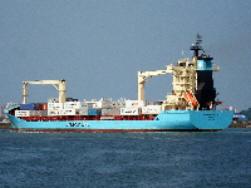 The Maersk Line ship "Roubaix."
The Maersk Line ship "Roubaix."- Learn more about Emission Control Areas (ECAs)
- Learn more about recent efforts under "Collaboration".
- Reducing Emissions from Goods Movement via Maritime Transportation in North America
In the first phase of this project (2013-2014), Exitthe US, Mexico and Canada developed the needed analyses for Mexico’s possible ratification of MARPOL Annex VI and establishment of an ECA. The second phase (2015-2016) Exit is focusing on to facilitate the establishment and implementation of an ECA in Mexico.
- Enhancing North American Enforcement of the IMO Maritime Fuel Sulfur Limits
The goal of this project Exitis to enhance North American capacity to assess compliance with, and enforce as appropriate, the International Maritime Organization’s fuel sulfur standards, particularly those applicable in Emission Control Areas (ECAs).
Emission Control Areas, or ECAs, set strict international standards which require that ships reduce emissions. A North American ECA was adopted and began in August 2012. ECAs are also in place for the North Sea and the Baltic Sea.
What are the requirements of the North American ECA?
Within the North American ECA, ships must switch the fuels they are using when operating within up to 200 nautical miles of the majority of U.S and Canadian Atlantic and Pacific coastal waters, French territories off the Canadian Atlantic coast, the U.S. Gulf Coast, and the main, populated islands of Hawaii.
The North American ECA also requires the reduction of nitrogen oxides from new ships after 2016.Why are we implementing an ECA for North America?
The international standards will bring important benefits for human health through reducing emissions from ships.
Other EPA Work on Ship Emissions
Fuel-Switching Demonstration
The U.S.-Mexico fuel switch demonstration showed the human health and environmental benefits of ships switching from high sulfur marine fuel (with fuel sulfur levels of about 35,000 ppm) to lower sulfur marine fuel (with fuel sulfur levels of 1,000 ppm).
The demonstration consisted of the following activities:
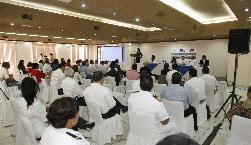
- In Fall 2009, an initial fuel switching demonstration was conducted on a small container vessel of Maersk Lines traveling between the Port of Houston, TX and the Port of Progreso, Mexico. Emissions reductions were estimated based on fuel used.
- In April 2010, a second demonstration was undertaken with a vessel of the German-based shipping line Hamburg Süd. EPA installed monitors to measure stack air emissions before and after fuel switching, and calculated emissions reductions based on a trip from Veracruz, MX to Altamira, MX and finally to Houston. EPA also developed port emissions inventories and conducted dispersion and deposition modeling to show impacts to air quality and pollutant loadings to the Gulf of Mexico.
- In addition to the Mexico and U.S. fuel switches, the Hamburg Süd vessel also switched fuels in Houston in July 2010 and then also conducted a fuel switch when it called on Santos, Brazil in August. View the press release from Hamburg Süd. Exit
- EPA produced a Final Report (above) presenting the results of the fuel switching demonstration, as well as port emission inventory development and emissions dispersion modeling for several ports in the Gulf of Mexico. The fuel switching project yielded valuable emissions data to show U.S. and Mexican policy makers in the Gulf specific reductions achieved from burning lower-sulfur fuels near land in U.S. and Mexican waters.
Collaboration with Mexican Stakeholders
An important early effort of the EPA-SEMARNAT collaboration on ship emissions was to raise the awareness of the Mexican public and key Mexican government agencies about the benefits of reducing these emissions through MARPOL Annex VI. Most recently the US, Mexico and Canada are working together through the Commission for Environmental Cooperation (CEC) to develop a Mexican ECA designation proposal to the IMO. The following activities have been undertaken:
May 2016: The CEC held a kick-off meeting for the Phase II Project on Reducing Emissions from Goods Movement via Maritime Transportation and the Project on Enhancing North American Enforcement of the IMO Maritime Fuel Sulfur Limits in North America in Mexico City. The meeting was attended by Mexican government ministries (including SEMARNAT, PEMEX, the Secretariat of Communications and Transportation, the Navy, the Ministry of Economy), the US EPA, and Environment Canada.
June 2015: The CEC completed Phase I of the Reducing Emissions from Goods Movement via Maritime Transportation in North America project. This project developed the technical tools and analyses needed to assist Mexico in establishing an ECA, including a draft ECA designation proposal to the IMO.
May 2015: EPA published the results of the first Mexican ship emissions inventory, which was used as the basis of technical analyses by the CEC.
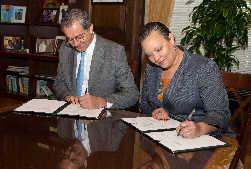
June 2013: At the Third Environmental Congress of PEMEX, Mexico's state-owned petroleum company, EPA presented about the North American ECA. SEMARNAT presented results of the first Mexican ship emission inventory.
September 2012: EPA and SEMARNAT signed a Memorandum of Understanding (MOU) on cooperation in coastal and aquatic environments to promote such joint work, including work on ship emissions. EPA assisted with outreach to Mexican government and industry stakeholders through a ship emission control technology seminar.
February 2012: To demonstrate EPA’s appreciation for this partnership, EPA’s Administrator Lisa Jackson presented Minister of Environment Elvira the Gulf Guardian Award for this work.
April 2010: EPA and SEMARNAT conducted a technical workshop on the outcomes of the fuel switching demonstrations to further government and industry awareness of the benefits of fuel switching and ECAs. Explore report, news, articles and presentations from the technical workshop.
Ship Technology Seminar
On September 26, 2012, a ship technology seminar was held to provide Mexican stakeholders with information about some of the ship technologies needed to meet the requirements of MARPOL Annex VI and an ECA.
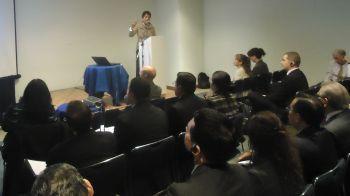
- MARPOL Annex VI and ECAs,
- the U.S. and Mexican government experience,
- a shipping industry view, and
- how this environmental policy is driving the development of ship emission control technologies.
The afternoon session focused on the available ship emissions technologies and implications for Mexican shipping and economic development. Both sessions increased the stakeholder awareness of the importance of addressing ship emissions, and the available technological options to do so.
Explore presentations, agenda and information from the seminar.
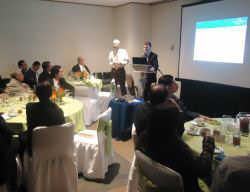
Shipping Company Perspective
- Implementation of Measures for Energy Efficiency in Container Terminals (Spanish) (PDF) (30 pp, 1.37 M)
- "Auriga Leader" is named best ship of 2009 (Spanish) (PDF) (7 pp, 365 K)
Presenter: CSAV Mexico
Technical Workshop on Fuel Switching Demonstration
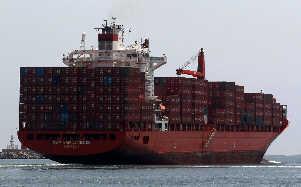 The Hamburg Sud demonstration vessel leaves Veracruz port on lower sulfur marine fuel.
The Hamburg Sud demonstration vessel leaves Veracruz port on lower sulfur marine fuel.Technical Workshop Resources
Explore report, news articles and presentations from the technical workshop.
